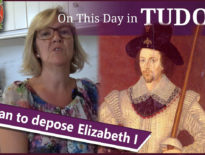On this day in Tudor history, 23rd July 1543, or 24th according to some sources, Marie de Guise and her baby daughter, Mary, Queen of Scots, escaped from Linlithgow Palace, helped by Cardinal David Beaton, and taken to Stirling Castle.
Why? What was going on in Scotland at this time?
Find out all about Mary's early months as Queen of Scots, and why Beaton helped her and her mother to move to Stirling, in today's talk.
Also on this day in Tudor history, 23rd July 1596, Henry Carey, 1st Baron Hunsdon, Privy Councillor and Lord Chamberlain, died at Somerset House in London. Hunsdon was the son of Mary Boleyn, nephew of the late Queen Anne Boleyn, and cousin and favourite of Queen Elizabeth I. Find out more about him in last year’s video:
Also on this day in history:
- 1563 – Death of Cuthbert Vaughan, soldier and Muster-Master and Comptroller of the English garrison at Newhaven (actually Le Havre), from the plague.
- 1584 – Death of John Day, Protestant printer, bookseller and publisher of John Foxe's “Actes and Monuments” (“Book of Martyrs”), at Walden in Essex. He was buried at Little Bradley parish church in Suffolk.
Transcript:
On this day in Tudor history, 23rd July 1543, or 24th according to some sources, Marie de Guise and her baby daughter, Mary, Queen of Scots, escaped from Linlithgow Palace, where they were being watched, and were subsequently taken to Stirling Castle. They were helped by Cardinal Beaton.
Why did they have to escape? What was going on?
Well, let me tell you a bit more…
Marie’s husband, King James V of Scotland, had died on 14th December 1542, leaving the throne to his six-day-old daughter, Mary, who became Mary, Queen of Scots. Due to Mary’s age, a regent was necessary and two men vied for the position: Protestant James Hamilton, 2nd Earl of Arran, who was next in line to the throne after Mary, and Catholic Cardinal David Beaton, Archbishop of St Andrews, who claimed that James had appointed him regent in his will, which was unfortunately viewed as a forgery. Arran won and was appointed Governor and Protector of Scotland, while Beaton was arrested, accused of inviting France to invade Scotland, and put under house arrest at his home at St Andrews.
In the summer of 1543, Arran negotiated an alliance with Henry VIII which included the marriage of Henry’s young son, Prince Edward, the future Edward VI, to Mary, Queen of Scots. The Treaty of Greenwich was signed on 1st July 1543 and it was decided that Mary would move to England at the age of ten to marry Edward. The treaty, which would see the union of the thrones of England and Scotland, was greeted with resistance by those in Scotland who favoured the Auld Alliance, i.e. Scotland’s relationship with France. Beaton was able to take advantage of this and on 20th July 1543 he and his supporters signed a bond, the Secret Bond or Band, agreeing to resist the terms of the treaty and to protect the young queen from England’s plans. On 23rd July 1543, Beaton and his armed supporters mustered at Linlithgow, where Mary and her mother were residing, and it was agreed that Mary and Marie would be moved to Stirling Castle. On 27th July 1543, mother and child were escorted by an armed guard of 3,500 men, to Stirling and Mary was crowned there on 9th September 1543.
In December 1543, the Scottish Parliament annulled the Treaty of Greenwich and renewed the country’s Auld Alliance with France. This led to the Rough Wooing, a war between Scotland and England, which sought to force a marriage between Mary and Edward, and to weaken Scotland. The war was eventually brought to an end in 1550 by the Treaty of Boulogne.
Mary didn’t marry Edward, instead in 1558 she married the Dauphin Francis, son and heir of King Henry II of France. Francis became King of France, and Mary his queen consort, in 1559 following the death of Henry VII, but Francis sadly died in December 1560 and Mary returned to Scotland in August 1561.
But what of Cardinal Beaton who had helped Mary and Marie?
Well, the cardinal was murdered at his home, at the castle of St Andrews, on 29th May 1546 by a group of lairds from Fife whose grievance against Beaton included the recent execution of Protestant preacher George Wishart.
Mary herself came to a sticky end when she was executed in February 1587 after being implicated in plots against Queen Elizabeth I.



Leave a Reply